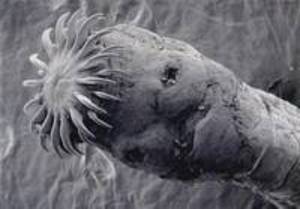What is a Dog or Cat Tapeworm?

Tapeworms can infect dogs and cats. Owners may notice rice-grain-like segments of tapeworms in feces or in the fur around the anus. Most tapeworms will not make pets ill, but some can be contracted by owners and make them quite unwell.
Tapeworms are a different parasite to other types of worms found in dogs and cats. They have flattened, segmented bodies, while other worms have rounded bodies. Adult tapeworms live in an animal's small intestine. Tapeworms vary in length from a few millimeters to several meters, depending on the species.
Each segment is independent of the others and is responsible for feeding itself and for reproducing. Tapeworms have no digestive system and they eat by absorbing nutrients through the body wall of each segment, not through a mouth. Their food is whatever its host has eaten and which is in the intestines.
|
"Each [tapeworm] segment is independent of the others and is responsible for feeding itself and for
reproducing... each segment is a hermaphrodite � it has both male and female organs!"
|
Adults have three basic bodyparts:
- a scolex at one end, a series of suckers or hooks which attach to the intestinal wall to prevent the tapeworm being washed away with the flow of food through the gut.
- a neck behind the scolex from which new segments grow.
- the chain of strobil, or segments. Each segment is known as a proglottid. The newest and most immature segments are closest to the neck.
Each segment is a hermaphrodite, it has both male and female organs! When a segment mates with another, the eggs are fertilized within the segment. When the segment is full of eggs, it is termed 'gravid'. In most dog and cat tapeworms, the gravid segments are released when they reach the end of the chain of strobila, a little like a conveyor belt.

However, a dog or cat cannot be reinfected by accidentally ingesting
these eggs. Tapeworms require some time in a host of a
different species in order to mature to adults. The first host, in which the juvenile stages of the tapeworm
develops, is known as the 'intermediate host'. The animal in which the adults
develop is known as the 'definitive host'.
When swallowed, the embryo hatches and develops into a immature worm within a cyst. These cysts tend to develop in organs such as the liver, heart or lungs, can destroy much tissue and be extremely damaging to the health of the intermediate host. Once the cyst has been eaten by the definitive host, the cyst wall is digested in the host�s gut. The immature parasite attaches to the intestinal wall and the neck begins producing proglottids.
|
Anti-tapeworm treatments
|
Pet Shed's most popular solutions for ridding your pet of
tapeworms
|
Tapeworms generally cause little harm or inconvenience to their definitive hosts. Pets with tapeworm infections may experience digestive upsets, itching of the bottom and vomiting. Some worms can be several feet long and can potentially cause intestinal blockage, but this is exceedingly rare.
Infected dogs often 'scoot' (drag their bottom) across the ground or carpet due to irritating tapeworm segments. As humans can be infected with tapeworms contracted from dogs or cats, it is important to treat cats and dogs at least every three months to prevent them being passed on. Products containing the ingredients called "praziquantel" or "epsiprantel" are most reliable.
Many wormer products which treat other intestinal worms will combine tapeworm treatment. Your veterinarian can advise you on the most appropriate treatment for your pet.
�
|
References
|
| Payne P.A., Carter G.R. Internal Parasites of Dogs and Cats. In: A Concise
Guide to Infectious and Parasitic Disease of Dogs and Cats. International Veterinary Information
Service, Ithaca, NY. www.ivis.org Bowman D.D et al. Gastro-intestinal Parasites of Dogs and Cats. In: Companion and Exotic Animal Parasitology. International Veterinary Information Service, Ithaca, NY. www.ivis.org Tilley, L.P., Smith, F.W.K. The Five Minute Veterinary Consult Canine and Feline. Second Edition. Lippincott Williams & Wilkins, Baltimore, 2000.S |